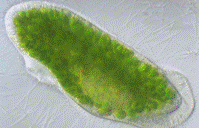Papers in the Biological Sciences
Document Type
Article
Date of this Version
2011
Abstract
Background: Urea amidolyase breaks down urea into ammonia and carbon dioxide in a two-step process, while another enzyme, urease, does this in a one step-process. Urea amidolyase has been found only in some fungal species among eukaryotes. It contains two major domains: the amidase and urea carboxylase domains. A shorter form of urea amidolyase is known as urea carboxylase and has no amidase domain. Eukaryotic urea carboxylase has been found only in several fungal species and green algae. In order to elucidate the evolutionary origin of urea amidolyase and urea carboxylase, we studied the distribution of urea amidolyase, urea carboxylase, as well as other proteins including urease, across kingdoms.
Results: Among the 64 fungal species we examined, only those in two Ascomycota classes (Sordariomycetes and Saccharomycetes) had the urea amidolyase sequences. Urea carboxylase was found in many but not all of the species in the phylum Basidiomycota and in the subphylum Pezizomycotina (phylum Ascomycota). It was completely absent from the class Saccharomycetes (phylum Ascomycota; subphylum Saccharomycotina). Four Sordariomycetes species we examined had both the urea carboxylase and the urea amidolyase sequences. Phylogenetic analysis showed that these two enzymes appeared to have gone through independent evolution since their bacterial origin. The amidase domain and the urea carboxylase domain sequences from fungal urea amidolyases clustered strongly together with the amidase and urea carboxylase sequences, respectively, from a small number of beta- and gammaproteobacteria. On the other hand, fungal urea carboxylase proteins clustered together with another copy of urea carboxylases distributed broadly among bacteria. The urease proteins were found in all the fungal species examined except for those of the subphylum Saccharomycotina.
Conclusions: We conclude that the urea amidolyase genes currently found only in fungi are the results of a horizontal gene transfer event from beta-, gamma-, or related species of proteobacteria. The event took place before the divergence of the subphyla Pezizomycotina and Saccharomycotina but after the divergence of the subphylum Taphrinomycotina. Urea carboxylase genes currently found in fungi and other limited organisms were also likely derived from another ancestral gene in bacteria. Our study presented another important example showing plastic and opportunistic genome evolution in bacteria and fungi and their evolutionary interplay.


Comments
Published by Strope et al. BMC Evolutionary Biology 2011, 11:80, Copyright 2011 Strope et al., Used by Permission